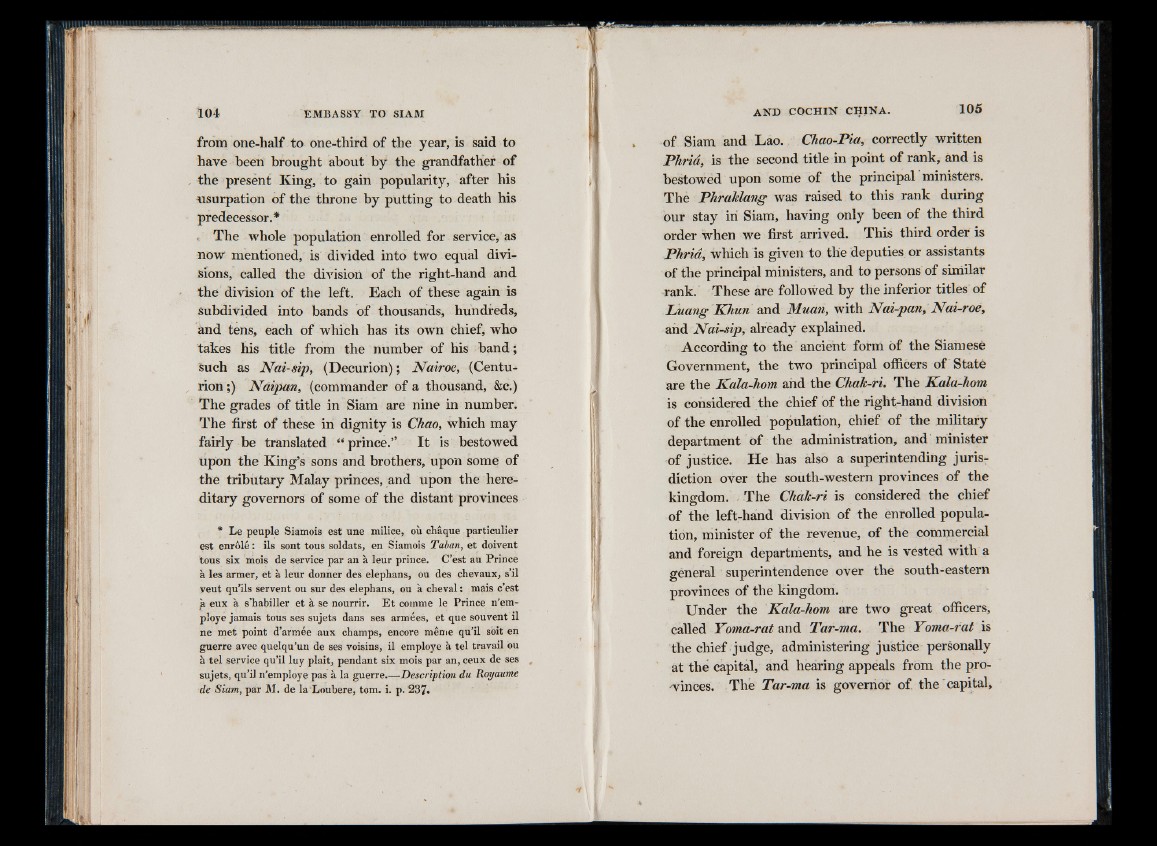
from one-half to one-third of the year, is said to
have been brought about by the grandfather of
the present King, to gain popularity, after his
usurpation of the throne by putting to death his
predecessor.*
The whole population enrolled for service, as
now mentioned, is divided into two equal divisions,
called the division of the right-hand and
the division of the left. Each of these again is
Subdivided into bands of thousands, hundreds,
and tens, each of which has its own chief, who
takes his title from the number of his band ;
Such as Nai-sip, (Decurion) ; Nairoe, (Centurion
;) Naipan, (commander of a thousand, &c.)
The grades of title in Siam are nine in number.
The first of these in dignity is Chao, which may
fairly be translated “ prince.” I t is bestowed
Upon the King’s sons and brothers, upon some of
thé tributary Malay princes, and upon the hereditary
governors of some of the distant provinces
* Le peuple Siamois est une milice, où chaque particulier
est enrôlé : ils sont tous soldats, en Siamois Taban, et doivent
tous six mois de service par an à leur prince. C’est au Prince
à les armer, et à leur donner des elephans, ou des chevaux, s’il
veut qu’ils servent ou sur des elephans, ou à cheval : mais c’est
^ eux à 6’habiller et à se nourrir. Et comme le Prince n’em-
ploye jamais tous ses sujets dans ses armées, et que souvent il
ne met point d’armée aux champs, encore même qu’il soit en
guerre avec quelqu’un de ses voisins, il employe à tel travail ou
à tel service qu’il luy plait, pendant six mois par an, ceux de ses
sujets, qu’il n’employe pas à la guerre.—Description du Royaume
de Siam, par M. de la'Loubere, tom. i. p. 237*
of Siam and Lao. Chao-Pia, correctly written
Phriá, is the second title in point of rank, and is
bestowed upon some of the principal ministers.
The Phraklang was raised to this rank during
our stay in Siam, having only been of the third
order when we first arrived. This third order is
Phriá, which is given to the deputies or assistants
of the principal ministers, and to persons of similar
rank. These are followed by the inferior titles of
Luang Khun and Muan, with Nai-pan, Nai-roe,
and Nai-sip, already explained.
According to the ancient form of the Siamese
Government, the two principal officers of State
are the Kala-hom and the Chak-ri. The Kala-hom
is considered the chief of the right-hand division
of the enrolled population, chief of the military
department of the administration, and minister
of justice. He has also a superintending juris7
diction over the south-western provinces of the
kingdom. The Chak-ri is considered the chief
of the left-hand division of the enrolled population,
minister of the revenue, of the commercial
and foreign departments, and he is vested with a
general superintendence over the south-eastern
provinces of the kingdom.
Under the Kala-hom, are two great officers,
called Yoma-rat and Tar-ma. The Yoma-rat is
the chief judge, administering justice personally
at the capital, and hearing appeals from the pro-
winces. The Tar-ma is governor of the capital.